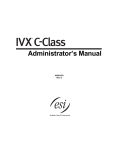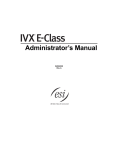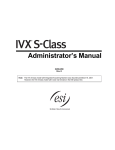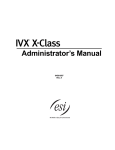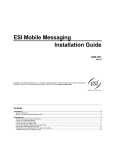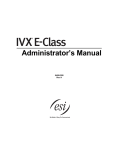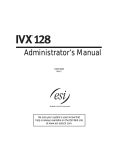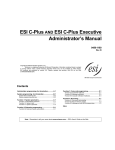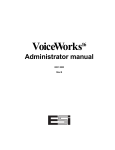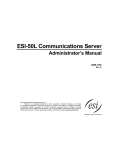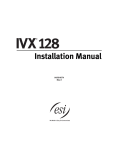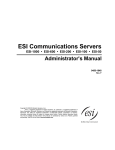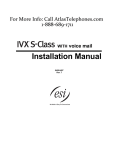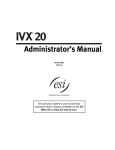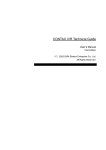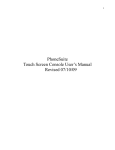Download ESI IVX X-Class User guide
Transcript
IVX S-Class Administrator’s Manual 0450-0458 Rev. A About ESI ESI (Estech Systems, Inc.) is a privately held corporation based in Plano, Texas. Founded in 1987, ESI specializes in telephone systems for the small to mid-size business. Since its days as a small start-up, ESI has enjoyed exceptional stability and growth while maintaining its dedication to small company values — including the need to take care of the most important part of the equation: your business. ESI pioneered the all-in-one telephone and voice mail system. The original IVX, introduced in 1996, represented a radical breakthrough in system design: the inclusion of a full suite of features within a single integrated telephone design. Committed to excellence, ESI is an ISO-9001-certified company — assuring that quality is fundamental. Copyright © 1999–2003 ESI (Estech Systems, Inc.). Visit ESI on the Web at http://www.esi-estech.com. IVX is a registered trademark, and Esi-Dex, Integrated Answering Machine, Quick Groups, Quick Moves, Virtual Mailbox Key, Auto Page, Quick Page and Verbal User Guide are trademarks, of ESI. Other registered trade names mentioned herein are trademarks of their respective owners. ESI phone systems are protected by U.S. Patent 6,067,349 and 6,252,944, and other patents pending. Product details are subject to change without notice. Table of contents Administrator programming................................................................................................................................... A.5 Administrator duties .....................................................................................................................................................................................A.5 Telephone system features.........................................................................................................................................................................A.5 Voice mail features.......................................................................................................................................................................................A.7 System programming overview..................................................................................................................................................................A.8 Access programming...................................................................................................................................................................................A.8 Programming keys.......................................................................................................................................................................................A.9 Entering alphanumeric characters............................................................................................................................................................A.10 System fixed numbering plan ...................................................................................................................................................................A.10 Function 1: System parameters............................................................................................................................. B.1 Function 13: Administrator passwords .....................................................................................................................................................B.1 Function 14: System clock ..........................................................................................................................................................................B.2 Function 17: System speed-dial .................................................................................................................................................................B.3 Function 3: Extension programming .................................................................................................................... C.1 Function 32: Extension feature authorization ............................................................................................................................................C.1 Function 5: Voice mail programming .................................................................................................................... D.1 Function 53: Guest/info mailboxes.............................................................................................................................................................D.1 Function 54:..................................................................................................................................................................................................D.2 Answering Machine Members - MB501 ....................................................................................................................................................D.2 Function 55: Message notification..............................................................................................................................................................D.3 Function 56: Cascade paging mailboxes...................................................................................................................................................D.5 Function 6: Recording............................................................................................................................................. E.1 Function 61: Re-record main greeting........................................................................................................................................................E.1 Function 62: Record directory names........................................................................................................................................................E.1 Function 63: Message-on-hold (MOH) programming ..............................................................................................................................E.2 Index This page included for pagination purposes only. IVX S-Class Administrator’s Manual Administrator programming Administrator programming You can program an IVX S-Class system from a 24 or 48-Key Digital Feature Phone in the system (while the system is operating). Read the S-Class User’s Guide first. Programming features require a clear understanding of user interface and application. Once you’ve accessed programming mode on a 24 or 48-Key Digital Feature Phone, the system will prompt for — and confirm — each keystroke action via voice commands and the display. You program both configuration data and recordings in the same manner. Administrator duties The System Administrator can perform the following tasks. • Administering station assignments. • Managing station feature authorization. • Maintaining the employee directory (if used). • Re-recording system prompts. • Administering manual change of day/night mode (if required). • Printing statistics reports (as desired). • Training new employees on the system’s operation User assistance The Verbal User Guide (HELP) includes all of the information included in the User’s Guide (with the exception of special features); additionally, the IVX user’s section of the ESI Web site (www.esi-estech.com) includes all the information in the User’s Guide. Telephone system features • ESI Feature Phones — Compact and stylish, yet rugged, the 48-Key Digital Feature Phone (also available a TAPI model), and the 24-Key Digital Feature Phone both include a high-quality speakerphone, an informative multi-functional display, and a specially designed key layout with several dedicated keys to minimize or eliminate the need to memorize codes. An expansion console is available for the 48-Key Digital Feature Phone. ESI also offers the 12-Key Digital Feature Phone with similar design and basic functions. At least one 24 or 48-Key Digital Feature Phone must be purchased with each S-Class system. • Extensive help — ESI’s Verbal User Guide uses spoken and displayed help prompts to help everyone from the Installer to the Administrator down to the least experienced end user. Easily accessible with one press of the HELP key. You may also go to www.esiivx.com for up to date online help. • Intelligent Caller ID — Allows one-touch automatic message return. • Live call recording — Can record any conversation or personal memo along with moving or copy2 ing of any recording to another user’s voice mailbox. • Call waiting — Includes helpful display, showing both calls’ Caller ID information, and easy one-key toggling between calls. ™ 1 1 This and all other references to Caller ID service within this manual assume the end-user organization subscribes to Caller ID service from its telephone service provider. 2 Not available on the S-Class with Integrated Answering Machine. A.5 Administrator programming IVX S-Class Administrator’s Manual • Conference calling — Includes eight conference bridges, and a conference may contain up to four parties, so the IVX S-Class system can support two conferences of four parties each. Analog phones on the system also may be parts of conferences. • Esi-Dex speed-dialing — Calls any number using three separate lists (personal, station, and 1 2 system); uses Caller ID information or direct keypad entries. • Dedicated overhead paging interface — Allows for external paging through overhead speakers or multi-zone paging units (amplification required) • 911 alert — Provides immediate line access if any station with line access dials 9 1 1 to report an emergency; sends a message via the serial port indicating the start date, time, station number and end-time of the 911; also sounds a warning tone at the operator station and displays, for example: 911 CALL FROM X102 JOHN JAMES • Status Indicator Lamp — Indicates three conditions of the 48 and 24-Key Digital Feature Phone: off-hook, ringing, and new voice mail message. A.6 ™ IVX S-Class Administrator’s Manual Administrator programming Voice mail features ™ 1 • Quick Groups — Makes it easy to leave voice mail messages for several users. • Quick Move — Records a conversation into another user’s mailbox. • Virtual Mailbox Key allows easy monitoring of a second mailbox. • Different mailbox types, including cascade, guest, and broadcast. • The IVX 42s with Integrated Answering Machine can record up to two simultaneous calls. Messages can be retrieved by any authorized 12, 24 or 48-Key Feature Phone or remotely from an offpremises location. The system can also be programmed to either call an off-premises number or commercial network to deliver messages. • Message-on-hold recordings — Up to five recording: three prerecorded, one customized, and one live entry. This feature is also available on using the Integrated Answering Machine mailbox 501. • Message Recycle Bin (undelete) — Remembers, and can restore, each mailbox’s 10 most recently deleted messages. This feature is also available on using the Integrated Answering Machine mailbox 501. ™ ™ 1 1 1 A.7 Administrator programming IVX S-Class Administrator’s Manual System programming overview The following menus show the programming functions available on the S-Class systems. For a S-Class system with four-port or two-port voice mail, refer to Programming menu for four port and six port SClass. For the S-Class system with Integrated Answering Machine™, refer to Programming menu for SClass with Integrated Answering Machine. Programming menu for four port and six port S-Class 1 System parameters 13 Administrator password 14 System clock 141 Set time/date 142 Automatic time setting 17 System speed dial 3 Extension programming 32 Extension feature authorization 5 Voice mail programming 53 Guest/info mailboxes 55 Message notification options 56 Cascade paging mailboxes 6 Recording 61 Record system prompts 62 Record directory names 63 MOH programming 631 MOH source 632 Record MOH 633 MOH volume Programming menu for S-Class with Integrated Answering Machine™ 1 System parameters 13 Administrator password 14 System clock 141 Set time/date 142 Automatic time setting 17 System speed dial 3 Extension programming 32 Extension feature authorization 5 Voice mail programming 54 Answering Machine Member 55 Message notification options 6 Recording 63 MOH programming 631 MOH source 634 MOH volume Access programming You may program from any 24or 48-Key Digital Feature Phone in the system: 1. Press PROGRAM. The normal station programming menu prompt will begin to play. Press HOLD to stop the prompt. 2. Enter the Administrator password followed by # (The default password is 456). You are now in programming mode (during this time, the extension will be automatically placed in DND). 3. Follow the system programming menu to program as you wish; and, when finished, hang up. Note: The system will automatically exit programming mode after 10 minutes of inactivity. Example: If your Administrator password is 864, enter programming mode by pressing PROGRAM HOLD 8 6 4 #. (To exit programming mode, hang up.) A.8 IVX S-Class Administrator’s Manual Administrator programming Programming keys During programming, the first line of the display will show the current item being programmed, and the second line will be the entry line. You can enter values as directed by the combination of the voice prompts and display. To enter multiple values, such as a list of extension numbers, separate each value by # (to exit the list, enter # #). To... Press ... Enter # Back up (i.e., reverse direction) Delete Exit Help Select/scroll ½ HOLD [Hang up] HELP ▼ (left-side scroll key) ▲ (right-side scroll key) What this does Confirms new or existing entry and advances to next programming step. Backs up to previous prompt without changing its value. Deletes data or recording. Exits programming mode and removes extension from DND. Provides more detailed instructions during programming. • During entry of a value, backs up. • If a list is present (“>” is displayed), scrolls to left. • Selects from options presented. • If a list is present (“>” is displayed), scrolls to right. • Inserts a space during entry of a name. Note: Either < or > in the display indicates that additional choices or values are available by pressing a corresponding scroll key (▼or ▲). A.9 Administrator programming IVX S-Class Administrator’s Manual Entering alphanumeric characters You enter names for extensions, departments, and branch IDs by pressing the dial pad key that corresponds to the character to be entered. The key’s possible entries will change each time the key is pressed, and the display will show this. When the desired character appears on the display, press # to confirm; the cursor will move to the next character position. You may move the cursor left (to correct an entry) by pressing the left scroll key (▼) or move right (to add a space) by pressing the right scroll key (▲). Key 0 1 2 3 Options 0, - (hyphen), _ (underline) Q, Z, 1, “_” (space) A, B, C, 2 D, E, F, 3 4 G, H, I, 4 5 6 J, K, L, 5 M, N, O, 6 Key 7 8 9 ▼ (left scroll key) ▲ (right scroll key) # ## Options P, R, S, 7 T, U, V, 8 W, X,Y, 9 Backs up and erases Adds a space [Enter] Ends the name Example: To enter a B, press 2 twice (the possible options to scroll through are A, B, C and 2). When B is displayed, press # to confirm; the cursor will move to the next character to be entered. To complete the name, press # #. System fixed numbering plan Numbers 0 1–12 100-123 124-129 199 290–299 300–309 500 501 520-529 560–580 590–594 600–699 Function Operator CO lines Digital extensions Analog extensions Overhead paging port Department pilots Guest/info mailboxes* Broadcast mailbox* Integrated Answering Machine mailbox ** Cascade mailboxes* Feature codes MOH recordings System speed dial *Not available on the S-Class with Integrated Answering Machine™. **Only available on the S-Class with Integrated Answering Machine™. A.10 IVX S-Class Administrator’s Manual Function 1: System parameters Function 1: System parameters Function 13: Administrator passwords These functions will display the existing password and prompt for entry of a new password. The passwords can be 2–8 digits long, followed by #. The Installer can change either the Installer or Administrator Password. Only those functions listed in the Administrator manual can be programmed via the Administrator Password. The default password is: Administrator Password (Function 13) = 456 Notes: Be sure to write down the new password and store it in a safe place. Accessing user station programming Should a user forget his password or if an employee leaves the organization, this feature allows the Administrator to enter a user's station programming and operate within it as if he were the user. From the user’s station, enter the Administrator password when the system prompts for the user password. Example: From station 105, entering 4 5 6 # instead of the user password (1 0 5 #) will enter the station’s user programming. (Default password is shown for this example). B.1 Function 1: System parameters IVX S-Class Administrator’s Manual Function 14: System clock Function 141: Set time/date 1. Enter a new time in a twelve-hour format. Example: Enter 1 2 3 3 for 12:33, or 3 1 5 for 3:15 (note that you need no leading zero for the time). 2. Select AM or PM by pressing a scroll key (either ▼or ▲). 3. Enter a new date in an eight-digit format, including leading zeroes. Example: Enter 0 7 0 4 2 0 0 3 for July 4, 2003 (note that leading zeroes are required here, unlike in Step 1). 4. Press # to finish the entry. Note: A built-in battery maintains the correct time and date, even in the event of a power loss. Function 142: Automatic time setting 1. Synchronize with CID This function, when enabled, synchronizes the real-time clock with Caller ID (CID) messaging: call processing compares the time of a CID message to the system real-time clock and, if the difference is more than two minutes, resets the real-time clock to match the time (hours and minutes) of the CID message. The system will analyze each such message (or — if it receives more than four calls with CID information within a one-minute period — as is needed). Select ENABLE or DISABLE by pressing a scroll key (either ▼or ▲). Choosing ENABLE will allow the CID data to update the time and date. Default: Enabled. 2. Adjust for Daylight Savings Time This function, when enabled, causes the real-time clock to adjust itself automatically for Daylight Savings Time (DST). Select AUTO or DISABLE for DST by pressing a scroll key (either ▼or ▲). Choosing DISABLE is best for those areas that don’t observe DST. Default: Disabled. B.2 IVX S-Class Administrator’s Manual Function 1: System parameters Function 17: System speed-dial Up to 100 system speed dial names and associated numbers can be stored, in location numbers 600–699, for access by any station. A user can initiate a system speed-dial by dialing the speed dial location number or by accessing the name through the Esi-Dex feature. In Function 32, access to system speed-dial can be denied to individual stations (see page C.1). Note: System speed-dialing overrides toll restrictions (Function 32, page C.1). 1. Enter the 3-digit location number to program, 2. Enter a ten-character name (see “Entering alphanumeric characters,” page A.10). 3. Enter the number to be dialed (including the line group 9, 8, or 7). Press the left scroll key (▼) to delete any character or digit entered in error. Here’s an example: 1. Speed Dial # 601 2. Name AUTO RENTL 3. Number 915552221212 The number dialed in Step 3 can be up to 30 digits long including the following special codes: Code What it produces # # DTMF tone ½ ½ DTMF tone F Flash hook P 2-second pause To insert a special code, press the right scroll key (▲) to select the desired special code: # , ½ , F or P. Press # to confirm the inserted character and continue. Press # # to complete the entry. Use the down arrow key (▼) to backspace. Once the number is saved you can use the scroll keys to move back and forth to view the number. To edit the number, you must delete it and enter the correct number. Example: To create a System Speed Dial number that dials 9, then 972-555-5644, then pauses for four seconds and finally dials #104, enter: 9 9 7 2 5 5 5 5 6 4 4 (then scroll to) P # (then scroll to) P # (then scroll to) # # 1 0 4 # Deleting a speed dial number To delete an entire speed dial number and name, delete the location number (6 X X) by pressing HOLD or the left scroll key (▼) during Step 1 in the speed-dialing procedure described above. B.3 Function 1: System parameters IVX S-Class Administrator’s Manual This page included for pagination purposes only. B.4 IVX S-Class Administrator’s Manual Function 3: Extension programming Function 3: Extension programming This section provides programming for extensions and department groups. Important: Where any gray shading (■) appears in an example, it represents values either unavailable to the function or unused in the particular example. Function 32: Extension feature authorization The Administrator can allow or deny many extension features on an extension-by-extension basis. A User, however, can only program and use allowed features (by using a combination of voice and display prompts) from his/her phone. Below is an example of a completed Programming Worksheet. The programming sequence is: 1. 2. 3. Ext. Name Rec. XXX 100 101 102 124 Default Jane Roger Sally Bill Y Y Y N 4. Toll allow 5. Sys. spd. dial 6. Ext. fwdg. 7. Ext Fwd to toll # 8. Trunkto-trunk Y Y Y Y Y Y Y Y Y Y N N N N N N N N N N N N N N N The programming steps are: 1. Extension number — Enter the extension number to program. 2. Extension name — Name the extension (if not previously named in Function 31). For each of the following features, press a scroll key (▼ or ▲) to select YES or NO. 3. Live recording feature — If enabled, will allow the user to record conversations. 4. Toll restriction — “YES” allows the user to place toll calls. If you select “NO,” the user can make only either non-toll calls or calls to numbers listed in the allow exception table. 5. System speed dial — “YES” allows the user to access and place system speed dial calls. 6. External forwarding — Allows the station user to enable the off-premises “reach-me” feature. The off-premises reach-me feature allows a caller that has been forwarded to voice mailbox to be transferred to an outside number. See the IVX S-Class User’s Guide for more information about the Off-Premises reach-me feature. Default: Disabled. 7. External forwarding — This feature is used in conjunction with external forwarding. When enabled, this feature lets the user program a long-distance number for external call forwarding. (Continued.) C.1 Function 3: Extension programming IVX S-Class Administrator’s Manual 8. Trunk-to-trunk — If enabled, this feature allows manual trunk-to-trunk transfers. While connected to an outside call, the user can press TRANSFER, dial an offsite number and then complete the trunk-to-trunk transfer by simply hanging up. Both outside parties are then connected. Note: 1 After the system dials the external forwarding number, a prompt will be played saying, “You are receiving a forwarded call. Press any key to accept.” This prompt will play continuously for 30 seconds. If the forwarded call is answered and the called party dials a digit, the forwarded call will be connected to the called party. If no digit is dialed, the caller is automatically forwarded to voice mail. While the two lines (trunks) are connected, the system constantly monitors the lines for open loop conditions (hang-up). If an open loop is detected on either line, the call is disconnected. The system also monitors for voice activity on the connected lines. If voice is no longer detected, the call is disconnected. Finally, if both lines 1 are connected for more than 60 minutes , the call will be disconnected. The default timer can be made longer or shorter. C.2 IVX S-Class Administrator’s Manual Function 5: Voice mail programming Function 5: Voice mail programming To simplify initial installation, all programmed extensions will automatically have the generic personal greeting, “You have reached the mailbox for extension [xxx].” The mailbox user should replace this with a personalized greeting. Each mailbox must have a greeting recorded for the IVX 42s to consider the mailbox active. Note: The IVX S-Class system with Integrated Answering Machine has 30 minutes of voice message storage. See Function 54 for more details. Function 53: Guest/info mailboxes1 Mailboxes numbered 300–309 can be programmed as either a guest or info mailbox. Enter the mailbox number and select Guest or Info by pressing a scroll (▼or ▲) key. Guest mailboxes Guest mailboxes are designed to be used by personnel, such as in outside sales or manufacturing, who do not have an extension assigned to them. A guest mailbox requires no programming other than the assigning of a name. Note: A guest mailbox can be handled like a regular extension (i.e., listed in the directory, assigned a station key, etc.), and is password-protected by default. If a programmable feature key is programmed as a virtual mailbox key with a guest mailbox number, the 2 key’s LED will blink, to indicate that new messages exist. To retrieve messages from a station, press VOICE MAIL ½ and then either press the DSS key or enter the mailbox number. To record a greeting, press PROGRAM ½ and the mailbox number; then press # to confirm, and follow the prompts. The default password is the mailbox number. To retrieve messages from the outside, press ½ and the mailbox number during the Main Greeting. Default: 300–309 as Guest. Info mailboxes Info mailboxes can be used to give callers information on a variety of different subjects by “publishing” these mailbox numbers. Info Mailboxes are identical to Guest Mailboxes except that the caller will not be given a record tone after the personal greeting (the information to be played). Instead, the caller will be forwarded as programmed in this function (default is the caller will be disconnected after the information is played). The maximum length of the record time is 14 minutes. Guest/info mailboxes are created or deleted here, but are turned “on” only when a personal greeting (the information to be played) has been recorded. Deleting the personal greetings will turn “off” the mailbox. To record a greeting, press PROGRAM ½ and the mailbox number; then press # to confirm, and follow the prompts. The default password is the mailbox number. (Continued) 1 2 Not available on the IVX 42s with Integrated Answering Machine. Otherwise, the key is a DSS key that allows for single-key transfer of a call with no message indication. D.1 Function 5: Voice mail programming IVX S-Class Administrator’s Manual Below is an example of a completed Programming Worksheet, showing the sequence of programming: 1. MB 300 302 2. Name Dana Literature 3. Type Guest Info 4. CF day 5. CF night X/MB/ID X/MB/ID Each programming step is defined as follows: 1. Mailbox number — Enter a mailbox number, 300–309. 2. Name — The mailbox name is used for the display, reports, and as a programming aid. The name length can be no longer than 10 characters (see “Entering alphanumeric characters,” page A.10). Default: The Mailbox number. 3. Type — Select a mailbox type: Guest or Info. Default: Guest. 4. and 5. Call forward (info mailbox only) — An info mailbox can be set to call forward after the personal greeting has played to an extension, department, a mailbox or a branch ID for day mode and differently for night mode. Default: ID9999 (automatic disconnect). Function 54: Broadcast mailbox Mailbox 500, the broadcast mailbox, is a special mailbox that can be used to leave messages for all of the system’s station users (extensions 100–123) who have recorded a personal greeting. The broadcast mailbox’s user list cannot be edited. Guest mailboxes are not included in the broadcast group. Refer to the IVX S-Class User’s Guide for more information. Answering Machine Members - MB501 For S-Class systems with Integrated Answering Machine. The answering machine can record up to two simultaneous calls. When a message is left, the message indicator on the 24or 48-Key Feature Phone will light. Messages can be retrieved by any authorized 24 or 48-Key Feature Phone or remotely from an off-premises location. Only one user can access the mailbox at a time. The system can also be programmed to either call an off-premises number to deliver messages. The first member in the list is allowed to program the Integrated Answering Machine via the PROGRAM key. This station is designated as the Master Station. All other users will only be able to play and delete messages. Only a 24 or 48-Key Digital Feature Phone can be installed on an extension designated as the Master Station. However, a 12, 24, or 48-Key Digital Feature Phone can be installed on an extension in the master list. Default: ext 100 D.2 IVX S-Class Administrator’s Manual Function 5: Voice mail programming Function 55: Message notification On a mailbox-by-mailbox basis for user or guest mailboxes including MB501 on the S-Class with Integrated Answering Machine, the system can be programmed to call an off-premises number or another extension to deliver messages or dial to an external commercial paging network to activate a user's pager. The IVX 42s will call or page when the first new message has been left in a mailbox and will repeat (at the interval of minutes programmed in this function) until the new message(s) have been deleted, saved or moved. The user can program either a phone or pager number. The Administrator can set, on an individual-station basis: • The number to be called • A delay period • The number of attempts (maximum of 99) • The interval between attempts • A “quiet period" to suspend phone delivery — e.g., late at night (the quiet period is an on-and-off time that applies to all days of the week) Note: For systems with the Integrated Answering Machine, MB501 must be programmed. Note Only pager or phone notification can be programmed, not both. Function 551: Station delivery options Programming of the station options, as shown below, can be performed by the Administrator. In addition, the user can change his phone number and pager number (but not phone or pager delay time). The phone number’s maximum length is 24 digits. 1. Phone 2. Pager 1. Number 9725556789 9725551234 2. Delay 30 0 3. Attempts 6 10 4. Interval 60 30 5. Quiet on 10:30PM 6. Quiet off 7:15AM To program, enter the station/extension number and choose 1 for phone number or 2 for pager number. Then, follow the prompts to set the parameters below. 1. Phone/pager number — The number to be dialed (without the CO line Group [9, 8 or 7]). 2. Delay — How many minutes the system is to wait before dialing the phone or pager number. This allows the user to pick up a message if he is in the office. Range: 0–500. Default: 0. 3. Attempts — How many times the system will call/page. Range: 0–99. (0 turns off delivery.) Default: 3. 4. Interval — How many minutes should elapse between attempts. Range: 1–1440. Default: 30. 5. Quiet period on — When the quiet period should begin. Default: (None.) 6. Quiet period off — When the quiet period should end. Default: (None.) (Continued) D.3 Function 5: Voice mail programming Code # ½ F P IVX S-Class Administrator’s Manual What it produces # DTMF tone ½ DTMF tone Flash hook 2-second pause To insert a special code, press the right scroll key (▲) to select the desired special code: # , ½ , F or P. Press # to confirm the inserted character and continue. Press # # to complete the entry. Use the down arrow key (▼) to backspace. Once the number is saved you can use the scroll keys to move back and forth to view the number. To edit the number, you must delete it and enter the correct number. Function 552: Delivery/paging parameters The sequence of programming is as follows: 1. CO line access — Enter the CO line group (9, 8, or 7) that is to be accessed for delivery. Default: 9. 2. Maximum lines — Enter the maximum number of lines (in the selected CO line group) that the system can access simultaneously. Make enough lines available to accommodate high notification traffic (but be careful: if you make available all lines in the selected line group and high notification traffic occurs, the system could tie up all lines). Range: 1–19. Default: 1. 3. Pager dialing pause — When paging, the IVX 42s will send the mailbox number to be shown in the pager’s display. To allow time for the paging service to answer, enter the pause, in seconds, to occur between when the IVX 42s dials the pager number and when it then dials the mailbox number. Range: 0–20. Default: 6. D.4 IVX S-Class Administrator’s Manual Function 5: Voice mail programming Function 56: Cascade paging mailboxes1 In addition to individual mailbox paging, the IVX S-Class system can support up to 10 cascade paging mailboxes (520–529). These can be assigned to anyone who requires escalating levels of paging beyond the single level available in all user mailboxes. In this function, you program the paging numbers and number of times each is to be paged before the next paging number is added; additionally, the mailbox owner can program these settings. To record a greeting, press PROGRAM ½ and the mailbox number; then press # to confirm, and follow the prompts. The default password is the mailbox number. Cascade mailbox options The user can program up to three paging numbers, of up to 24 digits each, to be paged whenever the mailbox takes a new or urgent message. The system will page the first paging number (for the number of times listed), then add the second paging number (for the number of times listed), then add the third paging number and will continue to page all three pagers until the message has been retrieved. 1. MB 520 2. 1st Number 9725553232 3. Attempts 2 4. 2nd Number 9725554254 5. Attempts 3 6. 3rd Number 9725555452 To program this, enter: 1. The mailbox number — Range: 520–529. [Then press 1 to enter number programming, and proceed to Step 2.] 2. First pager number — The number to be dialed (without the CO line Group [9, 8 or 7]). 3. Attempts — How many times the system will page (up to 20) before adding the second pager number. Range: 0–99. (0 turns off delivery.) 4. Second pager number — The number to be dialed (without the CO line Group [9, 8 or 7]). 5. Attempts — How many times the system will page (up to 20) before adding the third pager number. Range: 0–99. (0 turns off delivery.) 4. Third pager number — The number to be dialed (without the CO line Group [9, 8 or 7]). Code # ½ F P What it produces # DTMF tone ½ DTMF tone Flash hook 2-second pause To insert a special code, press the right scroll key (▲) to select the desired special code: # , ½ , F or P. Press # to confirm the inserted character and continue. Press # # to complete. Use the down arrow key (▼) to backspace. Once the number is saved you can use the scroll keys to move back and forth to view the number. To edit the number, you must delete it and enter the correct number. 1 Not available on the S-Class with Integrated Answering Machine. D.5 Function 5: Voice mail programming IVX S-Class Administrator’s Manual Cascade paging parameters The cascade paging mailboxes will use the same CO line group and pager-dialing pause as programmed in Function 552 (see page D.4). Paging interval To program the paging interval parameter for a cascade paging mailbox: 1. Enter the mailbox number (520–529). 2. Press 2 to set parameters for the mailbox. 3. Enter the number of minutes for the interval between attempts. Range: 1–1440. Default: 0 Note: Once you change this setting from 0, you cannot reset it to 0. D.6 IVX S-Class Administrator’s Manual Function 6: Recording Function 6: Recording Function 61: Re-record main greeting1 The main greeting prompts are re-recorded here. Recording a prompt 1. Practice the prompt by recording and re-recording (start and stop by pressing 1). 2. When satisfied with its quality, press # to confirm. • Day main greeting — Plays to callers if the auto attendant is programmed to answer in day mode. Press 1 to re-record. Default: “Thank you for calling. Please dial the extension number of the party you wish to reach or dial 0 for the operator.” • Night main greeting — Plays to callers when the system is in night mode. Press 2 to re-record. Default: No recording. • Holiday main greeting — Plays to callers when the system has been manually placed in holiday mode. Press 3 to re-record. • Default: “Thank you for calling. Our office is closed in observance of the holiday. You may dial your party's extension at any time or please call back during regular business hours.” Note: While in holiday mode, IVX follows night mode programming for call routing. Note: Deleting a system prompt by pressing HOLD (instead of #) restores to the default recording. Function 62: Record directory names1 This function is accessible only if a directory branch has been created as part of auto attendant programming. Enter the extension number and record the name (and, if this is a by-alpha branch, enter the name key.) Default: Last name Important: Print the worksheet provided on your ESI CD for preparing directories and making future changes. As names change, the Administrator can enter this function and change any field via the Administrator password. 1. Ext. 102 113 2. Recorded name George Straite Janet Smith 3. Key 4 5 Note: To record the prompt “Enter the first letter of the person’s last name” you you must enter Function 61 and then enter the ID number of the directory branch. (Continued.) 1 Not available on the IVX 42s with Integrated Answering Machine. E.1 Function 6: Recording IVX S-Class Administrator’s Manual Each programming step is defined as follows: 1. Extension number — Enter the extension number for the directory name. 2. Record name — Press 1 to begin recording and press 1 again when finished. Function 63: Message-on-hold (MOH) programming MOH can be: • A live feed from an external music source connected to the MOH connector located on the side of the cabinet. • One of three default, generic MOHs pre-recorded by the factory. • One of up to five custom MOHs loaded into the system by using a cassette recorder connected to the MOH connector. Function 631: MOH source This selects the source that will be played to callers on hold. Code 590 591 592 593 594 Source Live external source* Pre-recorded music Pre-recorded with “please continue to hold” Pre-recorded with “dial 0 or extension from hold” 1 Customer-recorded message on hold * Dialing off-hold doesn’t work. Default: 592 (generic message-on-hold). Function 632: MOH recording 1. Connect the message/music source to the MOH port on the side of the cabinet. Note: The connector is monophonic-only — if you use a stereo source, you must either set it to output mono, if possible, or use a stereo-to-mono conversion cable (or adapter). 2. Enter 594. 3. Press 1 to begin recording. To aid you in queuing, the source will be played through the phone’s speaker. Note: The recorded material should not have a “beginning” or “end” — so that playback can loop continuously. 4. Press 1 when finished. The recording will play back so you can review it. 5. Press # to accept the recording. 1 Not available on the IVX S-Class with Integrated Answering Machine. E.2 IVX S-Class Administrator’s Manual Function 6: Recording Function 633: MOH volume If a custom MOH is recorded, the output volume can be adjusted in this function. Range: 1 (faint)–12 (loudest). Default: 6. Notes: If an external audio source such as a radio is used for MOH, adjust the volume at the source. To turn live MOH volume completely off, turn off volume at the source. E.3 Function 6: Recording IVX S-Class Administrator’s Manual This page included for pagination purposes only. E.4 Index Administrator Duties, A.5 Alphanumeric characters, entering, A.10 Esi-Dex, B.3 System speed dial, C.1 Function Function 3 — Extension Programming, C.1–B.4 Functions Function 1 — System Parameters, B.1–A.10 Function 5 — Voice mail programming, D.1–D.3 Function 6 — Recording, E.1–E.3 Integrated Answering Machine, D.2 Mailboxes Guest/info, D.1–D.2 Password, Administrator, B.1 Programming Accessing user station programming, B.1 Keys, A.9 System, A.8 System fixed numbering plan, A.10 Recording, C.1 Recording directory names, E.1 Speed-dialing. See Esi-Dex Status Indicator Lamp, A.6 Time/date, setting, B.2 Toll restriction, C.1 Voice mail programming Guest/info mailboxes, D.1–D.2 Integrated Answering Machine, D.2 Message notification, D.2–D.3 www.esi-estech.com




























